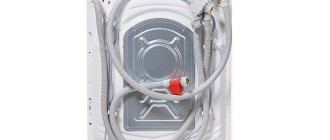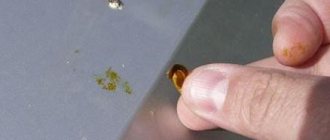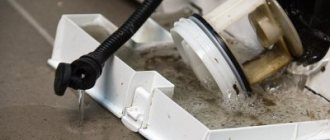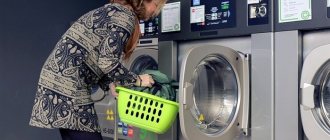Before purchasing a new washing machine, future owners usually think about where it will be installed. It is important to ensure a normal distance to sewerage and water supply. But after placing the device, the drains are often not long enough. Then there is a need to lengthen them. To do this, it is not necessary to call a specialist to your home. All the work is easy to do yourself.
When to extend the hose
In older houses, the size of bathrooms and kitchens is modest and does not always allow convenient placement of a large washing machine next to communications. In addition, the devices are usually equipped with drain systems of a standard size and their length does not exceed 1.5 m. Therefore, there is often a need to lengthen them.
Before starting this operation, it is important to take into account some technical features of the device. For high-quality pumping of waste water, the drain hose should be located at a height of up to 1 m above the floor level. Otherwise, the power of the drain pump will not be enough to completely remove the soap solution from the tank, and the liquid will stagnate inside.
Important! When connecting the device, the drains are positioned so that they are not in a tense state. In this case, the top point of the hose should be located 60 cm above the bottom. This value may differ for different models and manufacturers. All these features are described in detail in the manual for the device.
Varieties
Before you begin lengthening, you need to familiarize yourself with the main types of hoses.
Jellied
The inlet hose is a device used to connect the washing machine to the water supply system. It is with its help that water is supplied to the internal elements of the system. Such products operate under high pressure conditions and therefore reinforcement technology is used in their manufacture.
The connecting components of the structure can be made of steel, aluminum or plastic. Budget models use plastic fittings that are unscrewed and screwed on manually, without the use of additional tools. When working with steel or aluminum products, you will have to use a special wrench.
Drain
A drain hose is used to drain liquid from washing equipment. The following types of drain tubes are distinguished:
- Standard. Such products are produced in a certain length, the length of which can reach five meters.
- Telescopic. These are corrugated products that can easily be stretched to the desired length. When connecting telescopic tubes, you must be very careful so that they do not bend. The kinks may burst under strong pressure.
- Polypropylene. They are made from durable polypropylene. At each end of the product there are special fittings with which a device for washing clothes is connected.
Instructions on how to properly cover a door with self-adhesive film
Materials for work
To properly extend the drain hose of a washing machine, you will need the following materials and tools:
- a piece of rubber tube;
- a small plastic connector in the form of a tube, which can be easily replaced with a piece of rubber hose;
- 2 clamps.
The length of the hose for extension is selected after measuring the distance from the device to the sewer pipe. At the same time, it is taken into account that it should lie freely and not be in a tense state. It is especially important to follow these recommendations when water begins to flow through the system.
On sale there are standard hoses for automatic washing machines with a length of 1-5 m. There are also modular designs in stores, consisting of individual elements measuring 0.5 m. They allow you to expand the system and obtain the desired length. The total length of the drain should not exceed 3.5 m for normal pump operation. Otherwise, the motor will wear out to pump water over a long distance and will quickly break down.
Automatic washing machines have long moved from the category of wonders to the list of essential items...
The diameter of the drain hose at the ends is usually different. On one side the diameter is 19 mm, on the other - 22 mm. The wide end is intended for fastening to the connector, the narrow end is attached to the washing machine or sewer.
The clamps are selected according to the size of the washing machine drain hose. Usually it is 16x27 mm, but can be 19x22 mm or 22x22 mm.
Additional Tips
If you had to expand or change parts, do not forget to check whether your machine has enough cord to connect to the mains. If the cord is too short, or, on the contrary, the outlet is far away, then you need to pay attention to this point. It is better not to use extension cords to connect the washing machine to the network. This is fraught with serious damage: such extension filters often cause a fire.
Now you know how to extend the drain and intake hose of a washing machine. And no matter where your washing machine is, you will always find a way to successfully connect it to all communications.
Washing machine drain hose extension
The drain hose can be extended with or without a plastic connector. If such a device is available, the procedure is as follows:
- Place clamps on the ends of both parts.
- Place the extendable drain hose coming from the washing machine onto the connector.
- Place the purchased drain tube onto the device.
- Tighten the clamps using a screwdriver or other tool. It is important to ensure that the connection is tight.
- Connect the washing machine to the sewer and run the wash in test mode to evaluate the quality of the extension.
While the washing machine is operating, you need to monitor the connection location. If it leaks, tighten the clamps tighter or replace the components.
To extend the drain hose without an adapter, use a rubber or plastic tube of suitable diameter. The existing drain and the purchased part are pulled onto it from both sides so that they can be connected in the center and they fit very tightly. Both parts are tightened with clamps to secure the connection.
To start
Remember two main rules that must be followed before any repair work on household appliances.
Shut off the water
Close the water supply shut-off valves. They are usually located behind the washing machine on pipes. Now, even if the hose is damaged during operation, water will not flow.
De-energize
Remove the plug from the socket. To keep the wire out of the way, you can attach it with paper tape or wire to the back wall of the washing machine.
Preparing tools and materials
Before you begin repairing, replacing, or extending the drain hose, make sure you have everything you need on hand:
- pliers;
- screwdrivers;
- fastenings - metal clamp, coupling or adapter;
- sealant, we recommend using silicone;
- water for washing and cleaning;
- brush or cable;
- the spare parts themselves.
How to extend an inlet hose
If the length of the filler tube is not enough, it is easier not to increase it, but to connect a new part. You can purchase it in the same department as the components of the drainage system. To replace the tube, you do not need to disassemble the device itself. The procedure in this case will be as follows:
- If the automatic machine is already connected to the water supply system, turn it off and disconnect the tubes.
- Unscrew the fasteners without using tools. So, the plastic parts will remain intact.
- Install the new tube and tighten the fasteners also by hand without using tools.
- Open the water supply and check how tight the connections are.
- Run a wash to test the new filler tube.
Important! If you cannot find a filler tube of the required length on sale. Its size can be increased. To do this, you will need a similar water supply hose and an adapter. A 3x4 inch brass nipple is used for this. The tubes are simply screwed onto it from both sides.
After expanding or replacing parts, you need to make sure that the cable is long enough to connect the device to the power supply. It is best not to use extension cords or filters with multiple outlets for your washing machine. Such a connection is unreliable and is quite capable of causing a fire.
Easy to attach to water supply
Typically, installing a washing machine requires a water supply at a distance close to it. The water supply network is laid using metal or plastic pipes with a diameter of 15 mm.
There are three main ways to install equipment in a water supply system:
- Use of metal or plastic pipes and couplings.
- Using cranes.
- Using a fitting for pipes made of metal-plastic.
In the first case, a crimp coupling is required, which consists of two halves tightened with four screws. The faucet is screwed on when there is a rubber gasket just under the side where the hole is. After a convenient arrangement for connecting the coupling, it is determined that it is necessary to connect the machine inlet to the pipe using a crimp sleeve, which should compress the cold water pipe.
The technology for installing couplings involves the following actions when blocking the flow of cold water into the apartment:
- Preliminary cleaning of pipes from dirt with cold water.
- Tight, full clamping of the four clutch screws.
- Drill a hole in the pipe through the coupling using an electric drill with a diameter of 8-10 mm.
- Screw the ball valve into the coupling to seal the tap thread.
Features of some washing machine models
Not all SMAs have the ability to easily and quickly remove the drain tube or filler system part. For most models from manufacturers such as Ariston, Ardo, Indesit, LG or Samsung, the drain is located at the bottom of the device. Therefore, you have to tilt the washer strongly or even lay it on its side to get to the desired part. To do this, remove the bottom cover along with the drain filter. Then unscrew the connecting clamp and remove the tube. A new part is installed in the vacant space and the device is assembled in the reverse order.
Zanussi CMA models, like Electrolux products, are assembled in such a way that the drain parts can be accessed after removing the back cover of the device. To do this, first remove the top cover and only then remove the back wall, having first unscrewed the two bolts holding it in place. Then loosen the clamps and replace the required drain part.
Devices from AEG, Siemens or Bosch have an even more complex design. In such washing machines it is very difficult to get to the drain system. Their parts are located under the front panel. To remove it, first remove the detergent drawer. Then loosen the clamp holding the cuff and pull it out. After this, unscrew the bolts holding the front panel in place. Move the part up and towards you and remove it. Only after this can you start replacing the required part.
For a top-loading SMA, unscrew the bolts of the side cover and remove it. After this, loosen the clamps and replace the parts of the drainage system.
How to restore whiteness and freshness to a toilet using folk remedies
If going to the toilet becomes unpleasant because there are noticeable stains and an unpleasant odor inside, try cleaning the toilet with a brush. If you are not pleased with the result, move on to more serious cleaning methods. Folk remedies are well suited for cleaning minor and old deposits in private houses and apartments that have a plastic pipeline or a local sewer/cesspool system.
How to clean a toilet from heavy limescale with vinegar
With prolonged exposure, vinegar can dissolve hard urinary stones and limescale without damaging the surface of the toilet.
To clean the toilet:
- Use a plunger to clean out the sewer system and pump out the water from the toilet.
- Wipe dry areas that require treatment.
- Moisten a cloth generously with vinegar and apply it to the plaque.
- After 6 hours, clean the toilet and remove any remaining residue with a non-metallic scraper.
To enhance the effect, you can use heated vinegar essence or vinegar-soda solution (1 tbsp soda for 1 tbsp acid). The processing mechanism is the same as when washing with pure vinegar.
- "Mole";
- "Mister Muscle";
Scoop the water out of the toilet, pour in the product and flush by pressing the button on the tank.
Folk remedies are no less effective: pour ½ pack of soda with 1 tbsp. water (scoop out the water from the toilet first). After 15–20 minutes, pour a kettle of boiling water into it so that the dissolved blockages go into the sewer or street cesspool.
If you have a problem with how to clean a dirty toilet, use special or folk remedies. Use aggressive ones, like hydrochloric acid and autoelectrolytes, in extreme cases, because they are dangerous for the drain system.
For complex household appliances, which includes a washing machine, preventive maintenance is necessary. Otherwise, active use will quickly damage the machine.
One type of regular equipment maintenance is cleaning the washing machine filter. It is needed for the normal operation of the drain pump. The filter serves as a barrier that protects the pump from foreign objects entering the tank, lint from fabrics, wool, hair and other debris. A clogged filter makes it difficult to pump water out of the tank and can cause pump failure.
Therefore, we have prepared an instructional article about cleaning the filter and the main problems that washing machine owners encounter during cleaning.
Removing shipping parts
After the washer is unpacked, you need to check and remove all transport parts that provide rigid fixation of the tank and other rotating parts, which are thus protected from damage during transport.
These parts will be bolts, holders, rods and brackets that need to be disconnected. It should be noted that if the machine is turned on before the shipping parts have been removed, this may cause irreversible damage and may cause the machine to fail.
The main type of transport parts are bolts. With their help, the tank is fixed, which, after unscrewing, should hang on springs. This is the normal operating condition of the tank. These holes, which remain after the bolts are removed, are usually plugged by the plastic plugs supplied with the kit.
The brackets provide additional rigidity for transportation, and they also help secure the power cord and drain. Sometimes additional transport beams are placed between the tank and the body, which can be removed after the machine is tilted slightly forward.
These transport parts that you removed should actually be stored in case of moving the machine to a service center, to a new apartment or cottage, they should be mounted back to avoid damage to the machine during transportation.
The correct procedure for removing shipping parts can be found in the owner's manual that came with your machine.
Partial protection against leaks
To protect against leaks, a special tray with a built-in float can also be used. When water enters the pan located under the washing unit, the float rises and closes the switch contacts. A signal is sent to the control unit, the washing process is interrupted, and the pump begins to pump out water.
Prevention measures
Usually, a clogged washing machine hose occurs on its own. Small objects cannot get into it, as they will get stuck in the pump or drain filter.
This can be avoided by following these rules:
- Wash items using a special bag;
- Use water softeners;
- Regularly descale the machine;
- Wash only using powder - automatic;
- Before washing, turn clothing pockets inside out and remove all foreign objects from them.
Options for organizing drainage into the sewer system
There are several ways to install a washing machine with vertical or horizontal loading:
In addition to the difficulty of connecting a drain at a height, each method has its own advantages and disadvantages. For example, draining water into a sink or bathtub cannot be called reliable. Attachment to plumbing fixtures may not hold securely. In this case, a flood is guaranteed.
In addition, this can contaminate the bath itself, which will constantly need to be washed until it shines. When draining, the room sometimes smells unpleasant. And if you put the drain pipe into a siphon, then you can protect yourself from these odors.
You need to think carefully before choosing a specific drain connection point and height. It’s better to spend time and effort initially than to have to do it all over again and pay your neighbors for repairs.
The “overboard” drain pipe option is only suitable if the washing machine is installed in a country house where there is no sewer system. Moreover, the hose must be placed on a special tank, from which dirty water will need to be drained after washing.











